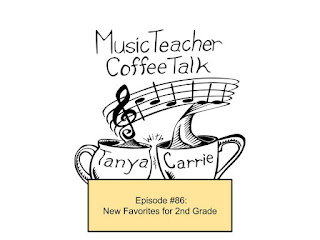Episode #120: PPP: All About Preparation
Upcoming Events!
Come see Carrie and Tanya at these upcoming workshops and events!
Carrie and Tanya will be presenting "Building Relationships and Community in the Music Classroom with Songs, Games, and Activities to Kick-Start the Year" in Anchorage, AK
Carrie will be presenting "Keep them singing! Keep them playing!" in Seattle, WA
Carrie and Tanya will be presenting "Kodály 101 for the 21st Century Teacher" in Fort Collins, CO
Main Theme: PPP: All About Preparation
We are starting a new series where we'll be focusing on the 3 stages of learning commonly found in a Kodály-inspired class: Prepare, Present, Practice. This episode is all about Preparation. Carrie and Tanya share specific ideas for songs and activities to prepare a melodic or rhythmic concept.
What is preparation? This is a discovery phase where students are experiencing the new element during musical activities, and the teacher is calling attention to that element through physical, aural, and visual tasks. The teacher is not naming it or showing its notation, but you are calling attention to how that element relates to previously known elements. Here are some specific ideas.
Preparing re
It is important to choose literature that features re in mi-re-do and do-re-mi patterns. Start first with songs in just the do-re-mi tone set, and then later you can expand to pentatonic songs using do-re-mi-sol-la.
Great songs for preparing re
Activities to prepare re
- Kinesthetic activities
- Physically show pitches with the entire body (stand, squat, squat lower)
- Body signs (mi touches waist, re touches thighs, do touches knees) while
- Curwen Hand signs
- Hand stafs
- Aural activities
- Questioning students while isolating a pattern. Is the pitch higher or lower? Is it a skip or a step?
- Activities where students have to freeze or do a specific movement when they hear a specific pattern such as mi-re-do
- Visual activities
- Place text or icons in space to show the melodic contour
- Place icons on the staff
- Circle or color code to show the pitch
- Music Street/Solfa Street houses (thank you Sr. Lorna Zemke!) and tone ladders
- Seesaw and Jamboard are great tools for students to individually manipulate icons, text, or note-heads
Preparing ti-tika
When doing rhythmic presentation, look for songs where that rhythmic element is very prominent and stand out as something different. When preparing ti-tika, avoid songs with tika-tika during early preparation so that students don't get confused. Also avoid songs with tika-ti during the presentation stage (you can bring those back to practice ti-tika and prepare tika-ti). Call attention to the fact there are 3 sounds on 1 beat and that the sounds are unequal with the longer sound first followed by 2 short sounds.
Great songs for preparing ti-tika
Zum Gali Gali
Activities to prepare ti-tika:
- Kinesthetic activities
- Body percussion
- Calling attention to beat vs. rhythm
- Aural activities
- Questioning students while isolating a pattern with the new element. How many sounds did you hear? How many beats does the new element take up? Are the sounds equal or unequal? Where is the longer sound?
- Quick reaction while teacher plays rhythms on a hand drum or piano and students do various body percussion to show what they hear
- Students can play a non-pitched percussion every time the new rhythmic element happens in the song
- Visual activities
- Stick notation for known rhythms and horizontal lines (long-short-short) for the new element
- Word compositions to represent various rhythms (ie fruit: ta=grapes, ti-ti=kiwi, tika-tika=watermelon, ti-tika=raspberry) either whole group on the board or small groups or pairs with cards
When do you move from preparation to presentation? WHEN THE STUDENTS ARE READY! During the preparation stage, the teacher is doing frequent formative assessments to see if the students are accurately identifying and performing the new element. Rhythmic elements will take longer to present than melodic and, in general, preparation tends to be shorter for older students.
Know Better, Do Better
Tanya reminded us of the concept of a "warm demander" which is highlighted in the book Culturally Responsive Teaching and the Brain by Zaretta Hammond and the importance of giving our students appropriately challenging tasks that bring your students into the "zone of proximal development while in a state of relaxed alertness." Students deserve
Work Smarter, Not Harder
Carrie talks about checkboxes in Google Docs and Sheets and ways to use those to clean up your planning tools.
Coda
Tanya recommends listening to Nick Drake, particularly the album Five Leaves Left.
Carrie recommends the podcast Buried Bones with Kate Winkler Dawson and Paul Holes.
.jpg)

%20(4).jpg)


Comments
Post a Comment